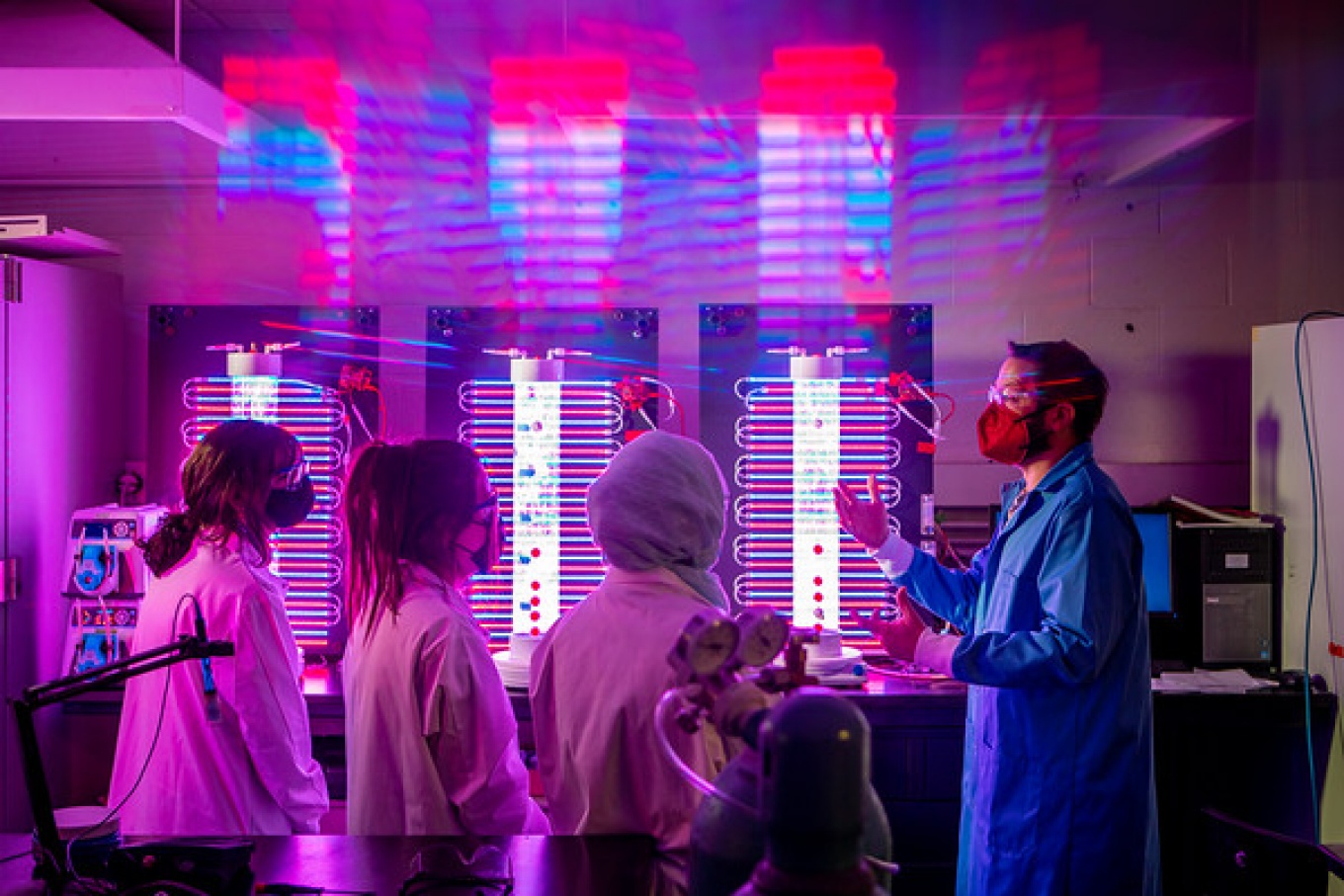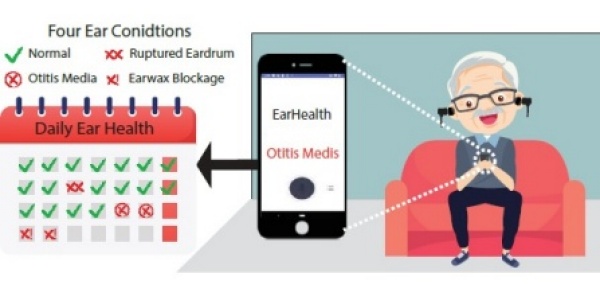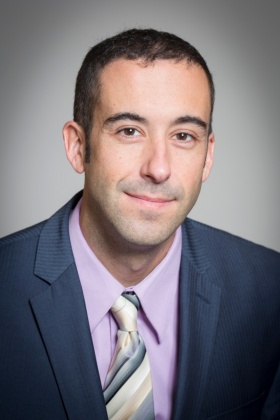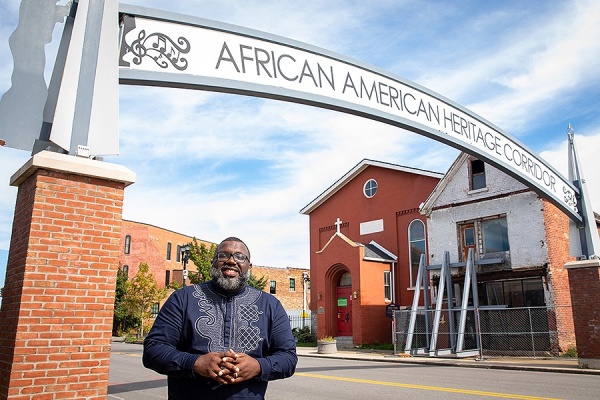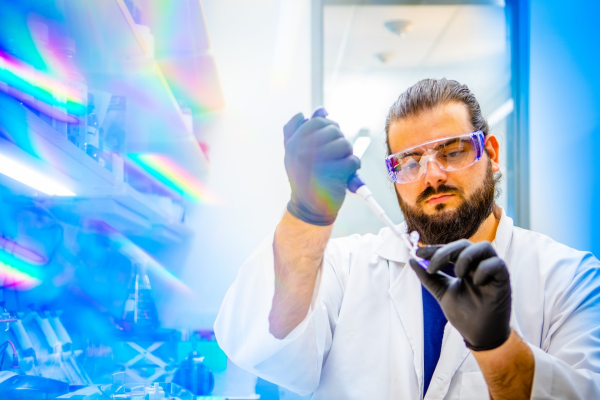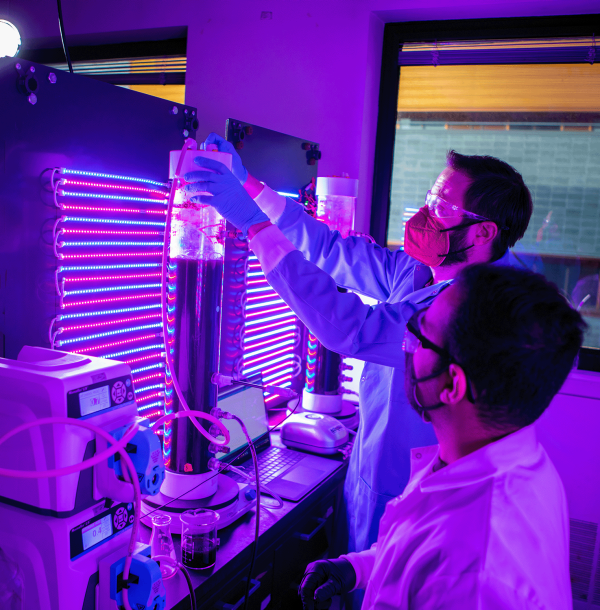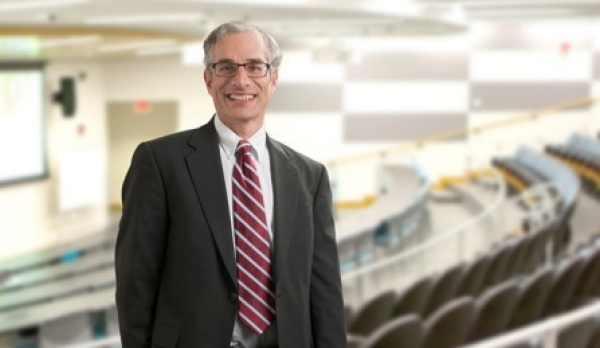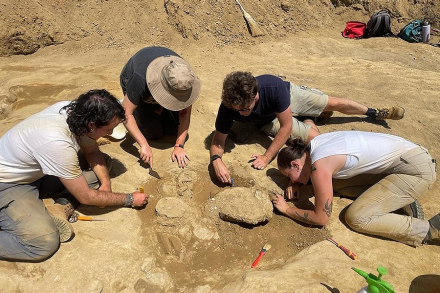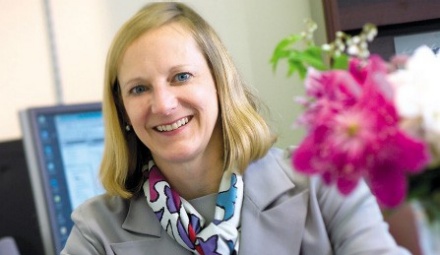2022: A look back in research, service and scholarly activity at UB
Students prepare to test wastewater for COVID-19 in the lab of engineering researcher Ian Bradley, right. Photo: Douglas Levere
By Cory Nealon
Release Date: December 22, 2022
BUFFALO, N.Y. – Identifying racial disparities in people with obstructive sleep apnea. Developing earbuds that spot ear infections. Monitoring wastewater for the next outbreak.
Providing insight and context into a horrific, racist mass shooting that left an indelible wound on Buffalo’s Black community, the region and the nation.
These and other scholarly activities spotlight what has been a challenging and, in many ways, hopeful year at the University at Buffalo and the communities it serves. After two-plus years of pandemic-related uncertainty, life has started to feel normal again.
And now, a new year is upon us. One that brings hope and promise that we, as a flagship university of New York State, can continue to unlock new knowledge that will help address society’s most pressing challenges.
But before then, let’s take one more look back at 2022.
Biotech | Earbuds that monitor ear health
An illustration showing how EarHealth works. Credit: University at Buffalo.
Earbuds are near ubiquitous, especially among children and younger adults. So why not use them to monitor ear health? That’s the thinking of computer scientist Zhanpeng Jin, who paired common earbuds with a smartphone that’s equipped deep learning-based analysis algorithms, a form of artificial intelligence.
The system, called EarHealth, sends a chirp through the earbuds of a user. It records how the chirp reverberates in the ear, creating a profile of each user’s unique inner ear geometry. Subsequent chirps – for example, once daily testing – monitor each ear for infections, earwax blockage and other conditions that alter the ear canal’s geometry.
As discussed in:
Finance | Startups woo investors, but miss revenue goals
Michael Dambra
Special-purpose acquisition companies, or SPACs, are having a moment.
Basically, they’re shell corporations listed on the stock exchange that raise money to acquire private companies. The arrangement allows SPACs to circumnavigate regulations related to traditional initial public offerings.
Researcher Michael Dambra has been studying the explosive growth of SPACs. Research he published earlier this year found that the more revenue growth a company projects when it announces it will be acquired by a SPAC, the more investors buy the SPAC’s stock — and the less likely those projections are to come true.
Based on the findings, he says investors should be cautious of any forecasts included in SPAC merger announcements.
As discussed in:
Racial violence | May 14 mass shooting

UB scholars helped provide context and insight following the May 14 shooting.
As Western New Yorkers and the nation grappled with the horror of the racist mass shooting on May 14 that killed 10 Black citizens in a Tops supermarket in Buffalo, UB researchers provided insight into the history of predatory investment in the community, as well as the challenges and hopes it faces while recovering from the trauma.
Henry-Louis Taylor, director of the UB Center for Urban Studies, discussed “The Harder We Run: The State of Black Buffalo in 1990 and The Present,” a report he led that concerns Buffalo’s Black population. Among its findings: There has been little, if any, progress among Black residents in relation to household income, homeownership, employment and other critical metrics.
Samina Raja, director of UB’s Food Lab, discussed how a failure to invest in predominantly Black neighborhoods in Buffalo has left residents with fewer options for healthy and affordable foods. Patricia Logan-Greene, associate professor of social work, discussed how gun violence is a public health crisis, but that we miss the full impact of gun violence on families and communities if we only look at the death toll.
Many other UB researchers addressed the shooting through their scholarship and community efforts.
As discussed in:
Indigenous studies | Celebrating 50 years
Patrons in the UB Anderson Gallery stand near Shelley Niro’s painting "Indian Brains." Photo: Meredith Forrest Kulwicki
When it was founded in 1972, UB’s Native American Studies program was among the first of its kind.
This program, now known as the Department of Indigenous Studies, celebrated 50 years with a ceremony in September with keynote speaker Oren Lyons, SUNY Distinguished Service Professor Emeritus. And earlier in the year, the university showcased the work of 48 artists from the Hodinöhsö:ni’ Confederacy, an impressive display of work with “Haudenosaunee voices steering the entire artistic conversation,” according to organizers.
Elsewhere, Dean Seneca, a researcher in the School of Public Health and Health Professions, discussed how racial equity problems persist in Buffalo Niagara.
As discussed in:
Black history | Improving how we teach
LaGarrett King directs the UB Center for K-12 Black History and Racial Literacy Education.
“History is not about patriotism. History is about helping us understand our humanity. That’s the good, the bad and the indifferent.”
Those are the words of LaGarrett King, who joined the Graduate School of Education in January as an associate professor of social studies education. He directs the UB Center for K–12 Black History and Racial Literacy Education, which hosted in July the 5th Annual Teaching Black History Conference, an event that brings together hundreds of researchers from around the world to learn curricular and instructional practices surrounding Black history education.
“The problem is our U.S. history curriculum dehumanizes those who are people of color. If we understand notions of Black history, then maybe our society will understand Black people,” he said.
As discussed in:
Cannabis | Is Delta-8 THC legal, safe?
Delta-8-tetrahyrdocannabinol is a hemp-derived cousin of cannabis that is often consumed in edibles such as gummies.
Delta-8 THC is everywhere, from gas stations to boutique shops. It’s a hemp-derived cousin of delta-9-tetrahydrocannabinol (THC) — more commonly known as cannabis — the active ingredient that provides the “high” people feel after ingesting it. Despite delta-8-THC’s rapid rise in availability, there is still much to learn about it.
A UB-led research team earlier this year published two papers based on its survey of more than 500 participants’ experiences with delta-8-THC and how it compared to cannabis.
“We found that people who are utilizing delta-8-THC feel fewer negative side effects … ,” said lead author Jessica Kruger, clinical assistant professor of community health and health behavior, who added that the work will better inform lawmakers, public health officials and consumers.
As discussed in:
Evolution | The importance of mucus
Petar Pajic, UB PhD student in biological sciences, prepares a saliva sample for separation and analysis. Credit: Douglas Levere / University at Buffalo
From the slime coating slugs to the saliva in our mouths, many slippery bodily fluids contain mucus. So how did this biological marvel evolve?
In mammals, the answer is many times, and often in a surprising way, according to a UB-led study on proteins called mucins published in August.
Scientists identified 15 instances in which new mucins appear to have evolved through an additive process that transformed a non-mucin protein into a mucin.
The work – a collaboration between the College of Arts and Sciences, School of Dental Medicine, and School of Pharmacy and Pharmaceutical Sciences – could have implications in understanding adaptive evolution and explaining certain disease-causing genetic variants.
As discussed in:
COVID-19 | Sleuthing for clues in wastewater
Inside the lab of engineering professor Ian Bradley, who is among UB faculty examining wastewater for COVID-19. Credit: Douglas Levere / University at Buffalo
With mass testing sites closed, public health officials faced a dearth of information related to COVID-19 infection rates.
But they’re not flying blind. Since 2020, UB engineers have been monitoring the virus in wastewater. The effort, which expanded in February to four additional Western New York counties, now serves as an early-warning system for changes in infection dynamics.
Also, a preliminary study led by UB scientists found that acetaminophen concentrations in wastewater spiked before other measures of COVID-19 in the community. The finding suggests that detection of pharmaceuticals could act as an even earlier warning system.
As discussed in:
Sleep | Identifying racial disparities
The sleep anea study was led by M. Jeffery Mador (above), associate professor in the Department of Medicine in the Jacobs School, and Yu-Che Lee, a medical resident in the Jacobs School.
Over the past two decades, more Black men in the U.S. have been dying from obstructive sleep apnea than white people or Black females.
That was the key finding from a study published in February by Jacobs School of Medicine and Biomedical Sciences researchers. The study identifies for the first time this significant disparity, giving clinicians insights into the problem to develop more tailored strategies and treatments.
Elsewhere, School of Nursing researchers Carleara Weiss and Carla Jungquist discussed, respectively, how daylight savings time can hurt sleep duration and quality, and how napping should be avoided for most adults.
As discussed in:
Archeology | Excavating a 2nd century Italian burial site
University at Buffalo and international students excavating one of the burials at Podere Cannicci in Tuscany in the summer of 2022. Photo courtesy of IMPERO Project
Archeologists today often find what tomb looters have left behind, usually pits of broken pottery.
That wasn’t the case for a recent excavation of a 2nd century BCE burial site in the southern Tuscany region of Italy, where UB researchers uncovered a golden crown and other Etruscan burial goods.
The work, led by Alessandro Sebastiani, assistant professor in the Department of Classics, provides a previously unseen glimpse of the Etruscan identity that survived the Roman conquest of Etruria. It suggests how the many entrenched and distinct characteristics of the Etruscan population survived in the presence of the dominant Roman power.
As discussed in:
Abortion | Legal scholar argues for reproductive rights
Lucinda Finley
In May, a leaked Supreme Court draft opinion suggested the court would overrule Roe v. Wade.
At the time, legal scholar Lucinda Finley, who has argued cases before the court and is an expert in reproductive rights, said such a ruling would further the perception that the judicial system is politicized, and put many women in harm’s way due to declining abortion access.
The decision was made public in June, and since then Finley has provided a counterpoint to the court’s ruling, arguing, among other things, that the First Amendment protects Americans who wish to donate to help women get abortions.
As discussed in:
Medicine | Kidney transplant dosing

Black kidney transplant recipients have a faster clearance rate of the immunosuppressive drug tacrolimus than white recipients, according to a study led by researchers at the School of Pharmacy and Pharmaceutical Sciences.
The study also found that tacrolimus-related adverse effects were more evident in female recipients, and were most prominent in Black women.
The findings are important because Black people are more likely to need a kidney transplant than white people, and their survival afterward is shorter, on average. Ultimately, the work could help lead to individualized approaches for transplant recipients.
As discussed in:
Advancing UB’s reputation | Faculty experts in the news
Amanda Nickerson
In 2022, UB faculty experts were featured widely in the news media, appearing in everything from podcasts and digital news outlets to public radio and television news. The tally is still growing, but as of mid-December roughly 300 experts were quoted in more than 14,000 news reports from local, national and international news media.
Some highlights include:
- Legal scholar Tolulope Odunsi spoke to NPR on the second anniversary of George Floyd’s murder.
- Political scientist Shawn Donahue discussing the 2022 midterm elections with The Associated Press.
- School violence expert Amanda Nickerson was quoted in The Washington Post about a rise in the number of school shootings.
- Communication professor Michael Stefanone appeared in the BBC on the “crippling expectation of 24/7 digital availability.”
- Geologist Tracy Gregg spoke to The Wall Street Journal as Mauna Loa, the world’s largest active volcano, erupted in Hawaii.
- Legal scholar Helen “Nellie” Drew was featured in The New York Times on NFL’s suspension of Deshaun Watson, who was accused of sexual misconduct.
- Architect Nicholas Rajkovich spoke to The Buffalo News about Buffalo being a “climate refuge.”
- Sociologist Erin Hatton appeared on WIVB-TV about the resurgence of labor unions.
- Numerous UB researchers were guests on WBFO’s “Buffalo, What’s Next?” – a program created to address why the May 14 mass shooting in Buffalo occurred.
2023 | Looking ahead to a new year
UB researchers from multiple departments will play a key role in the new $7.5 million semiconductor project. Photo: Douglas Levere
In addition to making critical advancements and applying their expertise to unfolding events, UB researchers in 2022 received numerous high-profile awards that are poised to make 2023 another exciting year of discovery, scholarship and service.
Highlights include:
- $7.5 million from the Department of Defense to lead a semiconductor chip development project.
- $5 million from the National Science Foundation to help older adults identify and protect themselves from online scams and disinformation.
- A $4.8 million clinical trial to study how to apply the UB-developed Buffalo Concussion Protocol to active members of the military who sustain a concussion.
- $3.5 million from the Department of Education to expand the UB Teacher Residency program, which has been lauded as a nationwide model for addressing the K-12 teacher shortage.
- $10 million from the National Science Foundation to develop software that academia, industry and government agencies use to manage high-performance computing infrastructure.
- $4.5 million from New York State to create a new research center to improve plastic recycling.
Media Contact Information
Cory Nealon
Director of Media Relations
Engineering, Computer Science
Tel: 716-645-4614
cmnealon@buffalo.edu
